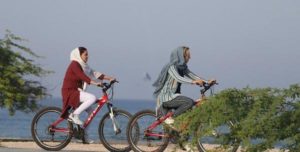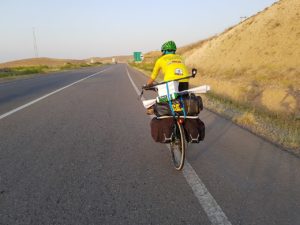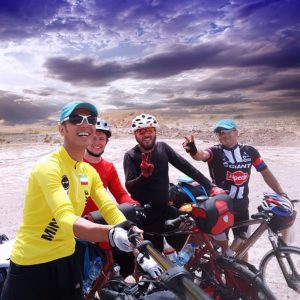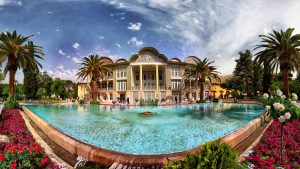In the age of carbon-neutral travel and the ever continuing quest to traverse the path less traveled, cycle travel has become a worldwide trend. Therein begs the question, is it possible to cycle in Iran? Absolutely, yes! And it is more common than you think. But before you decide to bike across one of the world’s most misunderstood countries, there are some things you should know.
Getting to Iran
All incoming tourists to Iran will need to obtain a tourist visa. Usually granted for a period of 30 days (which can be extended up to 90 days) the tourist visa is the first thing to consider when planning your trip. Visas are issued on arrival at some Iranian airports (such at Tehran’s Imam Khomeini International Airport) or visitors can apply in advance for a visa through a provider such as 1stQuest.
Importantly, cyclists coming across the country should know that visas on arrival are not available at land borders.
The lay of the land
Okay, so I’ll be brutally honest, Iran is really mountainous. Cyclists should be 100% prepared to be riding up and down hills, like, all the time!
Many people assume Iran is a big desert. Central Iran is quite dry and desert-like but also very mountainous and rich with agricultural lands. The northern crescent of Iran is covered with thick forests, rice and tea plantations whereas the south is quite tropical with palms and yes, more mountains.

Views from the Kashan – Isfahan Road in the Isfahan province, Iran
How hot?!
Although Iran’s climate is quite varied, most of the country experiences hot, dry summers, short spring and autumn periods and cool winters.
If you are planning to cycle in central and southern Iran the best time is from November to April. Although possible all year round, summer days will be over 30 degrees and can even exceed 60 degrees in some parts of the country. Shady roads are scant.
Also check out: When is the best time to travel to Iran?
Iranian hospitality
A quick Google search will show you story after story of cyclists who’ve traveled across Iran. These stories share one consistent theme: disbelief about the friendliness and generosity of the Iranian people. This is very true – Iranian people are extremely friendly. Persian hospitality is unrivaled and most travelers won’t have experienced anything like it before.
As a foreign cyclist, you will be of extreme interest to locals, especially in rural areas. Be prepared to embrace regular invitations of refreshments, dinner and even a place to stay for the night. For some tourists, this will be a culture shock. To help you navigate Persian hospitality I’ve written: An Outsider’s Guide to Iranian Hospitality.
Female cyclists
There has been a lot in the media lately about the Iranian government banning women from cycling. I cannot say whether this is fake news or otherwise, all I know is that it is not enforced. Iranian people often say, “everything yet nothing is illegal in Iran”, and in my experience, this is very true.

Taking a rest after riding through parklands in Tehran
The municipality of Tehran has recently installed bike share stations across the city. Both women and men ride these bikes daily. Further, my neighbor, a 60-year-old woman, goes cycling around our neighborhood in Tehran with her grandson every afternoon.
All women, foreigners and Iranians alike, are required by law to wear Islamic hijab in public. For cyclists, this means a headscarf, ankle length pants (leggings are fine) and a loose shirt to the elbow or longer that covers your bum.
For more information on dressing in Iran, see Dress code in Iran; Go long!
Traffic jam ahead
Tehran is notorious for its heavy traffic jams and crazy drivers however, outside the big cities, cyclists will practically have the roads to themselves.
Most roads across the country are sealed with bitumen or asphalt. As cyclists are not particularly common in Iran, it is recommended you use a light and have a rear-view mirror.

Iranian locals cycling in Kish Island, Iran
I’m biking solo
You might be wondering, is it okay to cycle across Iran alone? The answer is, yes, and many before you have done so.
Personally myself, I wouldn’t want to cycle alone through Iran. Unaccompanied women will receive unwanted attention, simply because Iranian’s will find your journey unusual. With that said, a couple of years ago Swedish woman Kristina Palten made headlines across the globe as she ran across Iran, completely solo. She made this journey to raise awareness about Iranian culture, and to quash anti-Islamic rhetoric in western countries. Read her full story here: https://www.alonethroughiran.com/.
Also check out: Solo Female Traveler in Iran: is it Safe?
Is it safe?
The official line of many governments is to exercise caution when traveling to Iran and to avoid border areas. Caution is usually advised due to potential civil unrest and the threat of terrorism, especially near the borders. As these warnings are subject to change, it is advisable to check with your own country’s guidelines before making your travel arrangements.
Unlike other countries in the region, thankfully Iran has sustained very few terrorist attacks in recent decades. Also, crime rates are the same, if not lower, than most European countries and violent crimes against foreigners are almost unheard of. For more information on safety see: Is it Safe to Travel to Iran?
Overall, foreign governments and the Iranian government alike advise tourists to respect Iranian culture and Islamic traditions when traveling to Iran. Iranians are highly educated and are not easily offended by foreign tourists, so don’t stress about the occasional faux pa.

The solo cyclist travels through Qazvin province, Iran (ganja2music on Wikicommons)
Buying a bike in Iran
Most travelers will bring their own bike but there are options to buy good quality bikes and gear once you arrive.
I would recommend buying your gear in Tehran (Iran’s capital). Gomrok is a neighborhood in downtown Tehran and is home to the bicycle bazaar. Once upon a time, Gomrok was home to Tehran’s red light district, but nowadays the brothels have been replaced with 100s of bicycle stores. Just a word of warning, if you are looking for a particular brand, beware of fakes.
What to pack

Cyclists enjoying the wild and open roads in Iran (ganja2music on Wikicommons)
- Suitable clothing: We’ve already covered clothing restrictions for women. Guys, you should know that men are also expected to dress modestly. Shorts will be okay while you’re biking, but long pants are better the rest of to the time. Due to the hot sun and high elevation, cyclists will want to wear clothes that will keep the sun off them.
- Bike safety accessories: Some roads won’t be lit so cyclists should wear high-vis/ have reflectors and a light. Rear-view mirrors are the best way to detect vehicles overtaking you. Obviously, we also suggest you wear a helmet.
- Water bottle/ camelback: Iran is a vast country with some long stretches of road without shops or drinkable water. Make sure you have ample water storage for your rides.
Best destinations
Most tourists decide to take a route through central Iran from Tehran and head south to Kashan, Isfahan, Shiraz then loop back to Yazd. But there are plenty of other destinations a little off the beaten track. Lar National Park just a couple of hours northeast of Tehran is home to Mount Damavand and is a popular cycling spot for Tehranis.
We’ve written plenty about the best places to visit in Iran, so be sure to check out:

Be sure to visit a Persian garden. A perfect example of typical Iranian garden design is the Eram Garden in Shiraz, Iran.
Where to sleep
Iran offers tourists a range of accommodation options. From hostels, homestays to five-star hotels, travelers are sure to find something to suit their needs. browse online and book Iran hotels through 1stQuest.
Cyclists might be keen to camp, but beware that there aren’t many typical campsites with kitchen facilities or hot showers in Iran.
Need help planning?
Do you need help planning your bicycle tour of Iran? 1stQuest has a team of dedicated travel specialists who can help you with Iran visa, insurance, accommodation, tour needs and more! 1stQuest specialize in making custom travel arrangements for both individuals and groups, offering decent discounts for packages.

